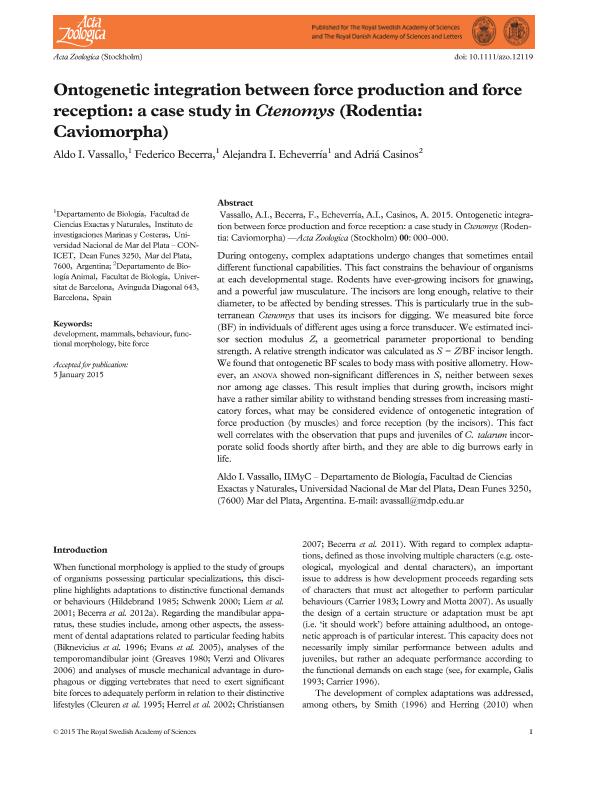Artículo
Ontogenetic integration between force production and force reception: A case study in Ctenomys (Rodentia: Caviomorpha)
Fecha de publicación:
04/2016
Editorial:
Wiley Blackwell Publishing, Inc
Revista:
Acta Zoologica
ISSN:
0001-7272
Idioma:
Inglés
Tipo de recurso:
Artículo publicado
Clasificación temática:
Resumen
During ontogeny, complex adaptations undergo changes that sometimes entail different functional capabilities. This fact constrains the behaviour of organisms at each developmental stage. Rodents have ever-growing incisors for gnawing, and a powerful jaw musculature. The incisors are long enough, relative to their diameter, to be affected by bending stresses. This is particularly true in the subterranean Ctenomys that uses its incisors for digging. We measured bite force (BF) in individuals of different ages using a force transducer. We estimated incisor section modulus Z, a geometrical parameter proportional to bending strength. A relative strength indicator was calculated as S = Z/BF incisor length. We found that ontogenetic BF scales to body mass with positive allometry. However, an anova showed non-significant differences in S, neither between sexes nor among age classes. This result implies that during growth, incisors might have a rather similar ability to withstand bending stresses from increasing masticatory forces, what may be considered evidence of ontogenetic integration of force production (by muscles) and force reception (by the incisors). This fact well correlates with the observation that pups and juveniles of C. talarum incorporate solid foods shortly after birth, and they are able to dig burrows early in life.
Palabras clave:
Behaviour
,
Bite Force
,
Development
,
Functional Morphology
,
Mammals
Archivos asociados
Licencia
Identificadores
Colecciones
Articulos(IIMYC)
Articulos de INSTITUTO DE INVESTIGACIONES MARINAS Y COSTERAS
Articulos de INSTITUTO DE INVESTIGACIONES MARINAS Y COSTERAS
Citación
Vassallo, Aldo Iván; Becerra, Federico; Echeverría, Alejandra Isabel; Casinos, Adriá; Ontogenetic integration between force production and force reception: A case study in Ctenomys (Rodentia: Caviomorpha); Wiley Blackwell Publishing, Inc; Acta Zoologica; 97; 2; 4-2016; 232-240
Compartir
Altmétricas




